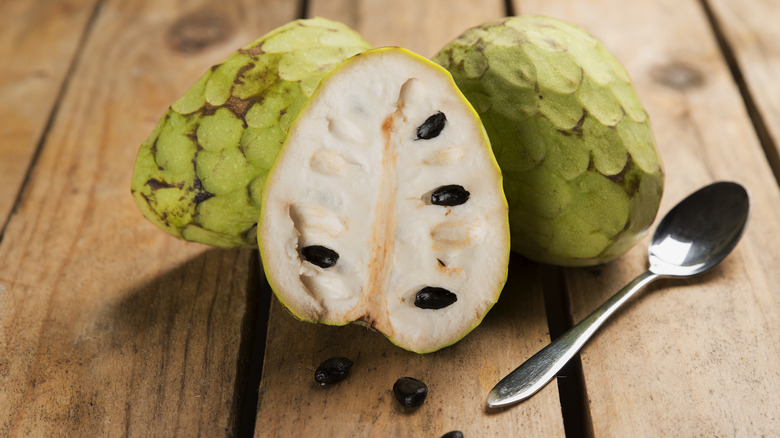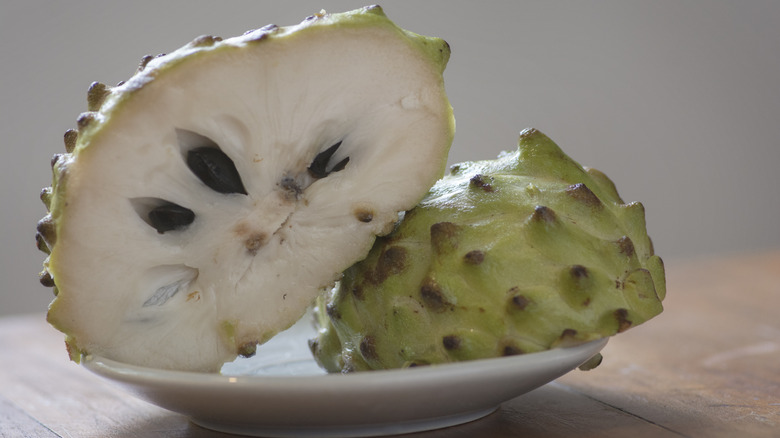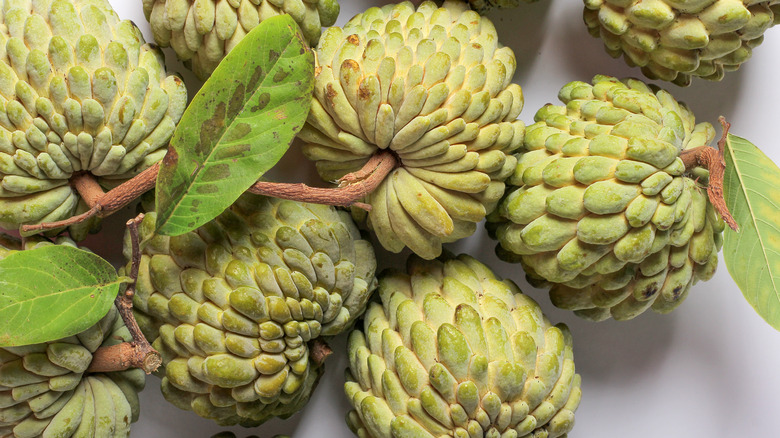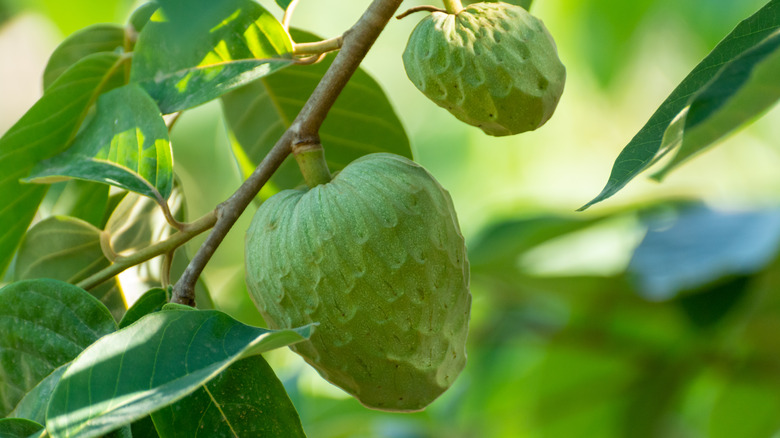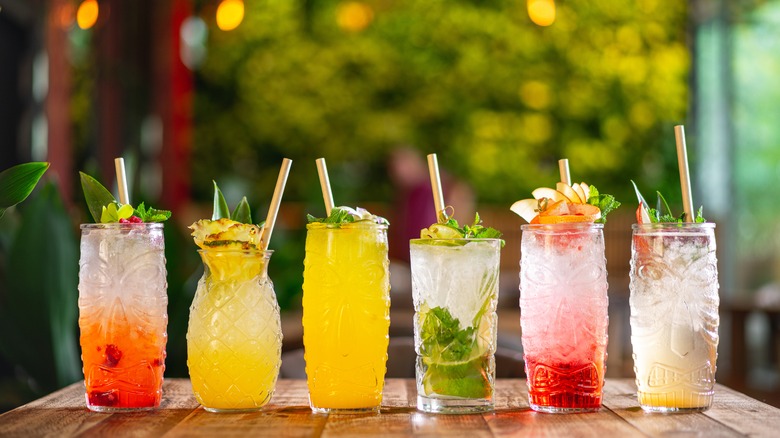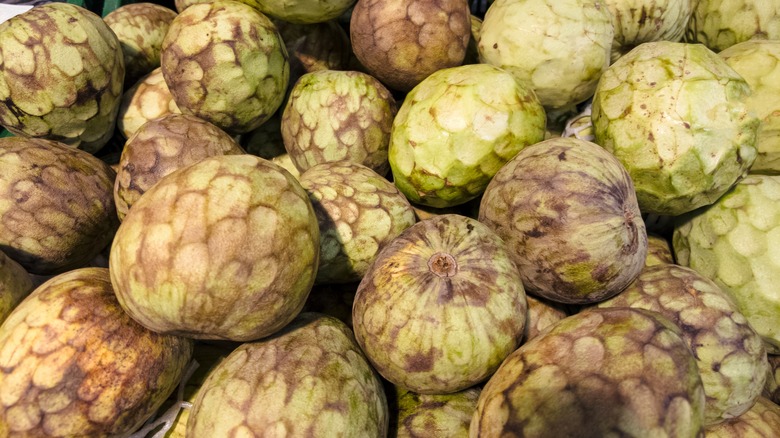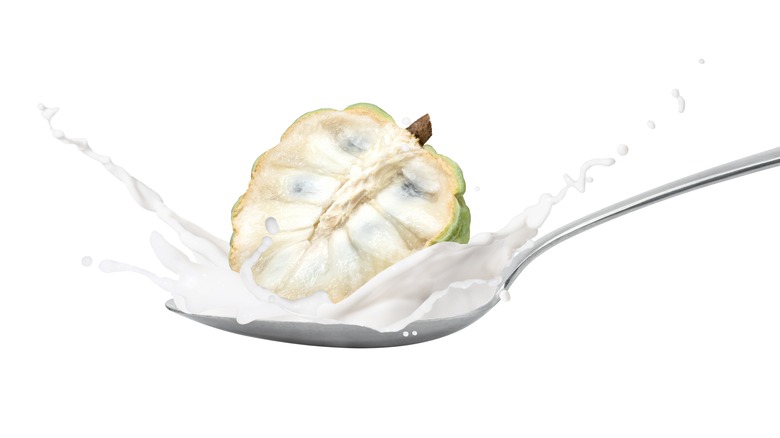Cherimoya Is The Andean Fruit Said To Embody Deliciousness
In his semi-autobiographical book, "Roughing It," Mark Twain describes cherimoya as a "rare and curious luxury...which is deliciousness itself." Given Twain's reputation for having an adventurous palate, that's fairly high praise. So what is this fruit that tickled Twain's taste buds? While Twain enjoyed cherimoya (Annona cherimola) in Honolulu, it originally hailed from the highland Andes valley. However, it can now be found more globally, sometimes known by other monikers including cherimolier, anona, and noina ostrelia (in France, Mexico, and Thailand, respectively).
Cherimoya (pronounced cheh-ruh-moy-uh in the United States) is also colloquially called a "custard apple" thanks to its creamy, smooth flesh. However, it should not be confused with an actual custard apple, another fruit within the same family. While cherimoyas are most frequently eaten — either on their own or prepared — there are other uses for the fruit as well. In some places, it is fermented in order to make a liqueur. And in Jamaica, the dried flowers from the cherimoya tree have been used to flavor snuff. But what is it and how do you eat it? Let's take a closer look at this delicious fruit.
What is a cherimoya?
A member of the Annonaceae family, cherimoyas grow in warm climates, often in higher elevations. The sweet fruit grows in Colombia, Ecuador, Bolivia, Venezuela, and Peru, as well as Chile where it is the country's national fruit. It is also grown throughout the Mediterranean and in New Zealand. In the United States, only Hawaii and southern California have a climate that supports the cultivation of cherimoya.
The scaled green exterior of the grapefruit-sized, heart-shaped cherimoya has led to comparisons to the appearance of an artichoke. Meanwhile, the flesh of the fruit is smooth, white, and dotted with several large seeds. The seeds themselves are toxic when crushed but are used in some countries as an insecticide or treatment for some parasitic skin diseases. The trees that cherimoyas grow on can reach up to 30 feet tall and have long leaves that are a similar light shade of green as the skin of the fruit when it has ripened. The leaves, which can grow as long as six inches and as wide as three and a half inches, are smooth on the underside and slightly textured on top.
Cherimoya vs. Custard Apple
Cherimoyas are nicknamed custard apples for their texture, but, as we mentioned, there is another similar fruit in the same family named custard apple, as well. Unsurprisingly, the custard apple (Annona reticulata) grows in the same regions as cherimoya. Also known as the wild sweetsop or sugar apple, its skin can be similar in color during the growing process, but it can eventually become brown or red with yellow tones. The scales are more like fingers rather than the artichoke-like appearance of the cherimoya's. Their flesh is a similar white color, as well.
As similar as they are, they aren't identical: The custard apple is smaller than a cherimoya. While cherimoyas can grow up to 11 pounds, custard apples top at out two. The most notable difference between the two is that the flavor of the custard apple is not nearly as prized as the cherimoya, particularly due to its inconsistent flavor profile. Instead, the trees are sometimes grown for decorative purposes, thanks to their beauty when they flower.
What does cherimoya taste like?
Cherimoyas have a sweet flavor that is a mix of banana and pineapple, sometimes with other hints of strawberry, kiwi, or papaya. Some have even likened its flavor to bubble gum. It also has a rich mouthfeel that's been compared to a soft and smooth pear, as well as custard. The tropical fruit is often eaten on its own, chilled and using only a spoon to dig the flesh out from its inedible skin. This way of eating cherimoyas, paired with their sweet taste, has earned them another nickname, "ice cream fruit."
While ripe cherimoyas may have a mouthwatering flavor and texture, like many fruits, if harvested too soon, they can be unpleasant. Cherimoyas that are picked before ripening can lack sweetness, becoming bitter as they ripen off the tree. Their texture is negatively affected too, developing a grittiness that stands in stark contrast to their silky ripened counterparts.
How to eat cherimoya
As mentioned, cherimoya is a sweet treat all on its own, sliced in half, and spooned out of the skin — being sure to avoid those toxic seeds, of course. When eaten this way, some also recommend squeezing just a bit of citrus, like lime, on top. Like most fruits, particularly tropical ones, cherimoya makes for a delicious addition to smoothies. Another popular preparation is to use it to flavor frozen treats like ice cream or sorbet. It can also be tossed into a fruit salad or served over oatmeal or yogurt.
If you're looking to bake with cherimoya, it can be used to make a sweet pie or custard. Meanwhile, if you want to add a sweet touch to your savory dishes like tacos or grilled proteins, substitute it for some or all of the pineapple in a pineapple salsa. It can also be incorporated into beverages, like the refreshing batidos. It's perfect for making tropical cocktails like a sweet piña colada or a Havana daiquiri.
Where to buy cherimoyas and how to pick them out
Since cherimoyas are a challenge to grow in most of the United States, outside of Hawaii and specific parts of California, they can be hard to find in local grocery stores though you may be able to find them at a specialty store or market. However, there are a number of online retailers that can ship them to your home.
Spring is the best time to buy cherimoyas — when they are perfectly ripe. If you're fortunate enough to find them in the store, look for cherimoyas that are soft to the touch and only slightly brown. Cherimoyas bear a similar reputation to avocados (and their cousins, bananas) in terms of the ripening process. They're only good on the counter for a day or two before they become overripe. However, if you're looking to keep them longer than that, you can easily freeze them by scooping out the flesh and placing it in a freezer-safe container or resealable bag.
Cherimoya nutritional information
Cherimoyas are nutrient-rich fruits — there are a number of benefits to consuming them outside of their unique flavor (per WebMD). High in Vitamin C, this sweet fruit can act as an immune booster and protect against sickness or lessen the length of the common cold. Cherimoyas are also rich in Vitamin B6, which is crucial for certain brain functions, particularly mood regulation. Just one cup of cherimoya has nearly a quarter of the daily recommended intake of Vitamin B6.
Cherimoyas also contain a number of anti-inflammatory and antioxidant properties, which may contribute to lower blood pressure and a decreased risk of various types of cancer as well as other chronic conditions like arthritis, heart disease, and diabetes. Additionally, cherimoyas have a large amount of lutein, which may help in maintaining eye health. Finally, cherimoyas are also high in fiber, which helps with digestion. With one cup of cherimoya clocking in at about five grams of fiber, it delivers nearly one-fifth of the daily recommended intake (via WebMD).
According to WebMD, the one caveat regarding cherimoya consumption is to avoid overindulging regularly. Cherimoyas contain a group of compounds called acetogenins, which have the potential to negatively impact nervous system cells. Some other foods that contain acetogenins include paw paws and avocados.
Overall, cherimoyas can be a healthy addition to a balanced diet when consumed in moderation.

